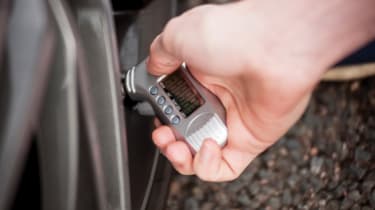How to make your tyres last longer
You should never hold off on buying new tyres when you need them, but you can take measures to ensure you get the most miles from a set
Tyres are one of the most critical elements to a car’s safety, performance and the enjoyment it delivers. It goes without saying that the quality, age and wear of a tyre have an enormous effect on its purchase on the road, so keeping on top of your rubber is paramount – especially if you’re looking to get the most out of a performance car.
We’d invariably recommend fitting new tyres once your current set is past its best, but there are ways to make your tyres last longer to deliver more consistent performance across their lifespan – as well as save you money. We’ve listed some tips below.
Run the correct tyre pressures
Having the correct pressure within your tyres keeps them within the operating window that they were designed to work in. If they’re under-inflated, the carcass can deteriorate and wear will be accelerated, along with fuel consumption (according to Michelin, under-inflating by 14psi can use up an extra tank of fuel in a year). A tyre will always lose a small amount of pressure with time, so it’s worth checking them every month. Your car’s recommended pressure can usually be found in the owner’s manual, inside the fuel filler cap or on the driver’s door jamb.
Correct wheel alignment
Setting your wheel alignment correctly is paramount for reducing uneven and excessive wear on your tyres, and making sure your car handles as it was designed to. Incorrect geometry can cause a tyre to scrub across the ground, inducing wear and drag. There is a compromise – for instance, some performance cars use aggressive camber angles to generate more grip, which increases wear on the inside shoulder – but the manufacturer-approved settings are a safe place to start.
Avoid unnecessary heavy braking
The hardest task for a tyre is heavy braking. In fact, maximum effort braking causes three times the wear of heavy acceleration, due to the abrasion of the tyre against the surface of the road. Of course, sometimes an emergency stop is unavoidable, but unnecessary heavy braking and ABS activations (or lock ups) will wear your tyres out fast. Focus on keeping a healthy distance to other vehicles to allow for softer, more gradual braking inputs.
Let them warm up
Most of us aren’t at our best first thing in the morning, and your tyres are no different. Give them a few miles to warm up before you put any extreme cornering, acceleration and braking loads through them. You wouldn’t thrash your engine from cold before the oil has had a chance to warm up, and neither do your tyres give their best until the compound has warmed up and softened. Slipping and sliding on cold rubber is a surefire way to accelerate wear.
Rotate your tyres
Tyres on each axle of a car tend to wear at different rates, whether that be because of which wheels are driven, or the heavier braking efforts withstood by the front tyres. Not only this, a tyre can wear asymmetrically due to the suspension geometry and alignment settings of a car. Periodically rotating your tyres – swapping your wheels from left to right and back to front – can mitigate this for more even wear, extending the life of your set. There are caveats though – you can’t swap your fronts and rears if they’re different sizes, of course, and direction/asymmetrical tyres can’t be swapped from left to right.
Don't overdrive
If you overdrive your tyres, you won’t tend to find any more grip or go faster – you’re only likely to accelerate their wear. On track, be smooth and work up to the limit of the tyres, without introducing sudden inputs that could induce a slide. This can apply on the road, too, particularly in powerful rear-drive cars that can involuntarily break traction with clumsy use of the throttle. Every time you hear your tyres squealing, you’re chipping away at their life expectancy.
Avoid road imperfections and debris
Whether it’s debris on the public road or razor-edged kerbs on a track day, try to be kind on your tyres by avoiding impacts as much as possible. A hard hit through a pothole can rupture a tyre instantly, and it’s worth being especially eagle-eyed for road imperfections on rainy days, when they could be hidden beneath puddles. If you’re going to use kerbs on a track, think about the angle you’re going onto and coming off them. If you’re parking up on a kerb (where legally permitted to do so), mount it slowly at 45 degrees – don’t scrub clumsily up against it.
Store them correctly
Tyres naturally deteriorate with time – even when you aren't driving on them – but storing them correctly when your car isn't in use can slow this process down. Keeping them in a cool, dry indoor environment like a garage can help prevent surface cracks appearing in the rubber, and when your car is out of action for an extended period, it's worth jacking it up or removing the wheels to avoid flat spots. Failing that, increasing the pressure by a few PSI can reduce the chance of flat spots when leaving your car standing.







